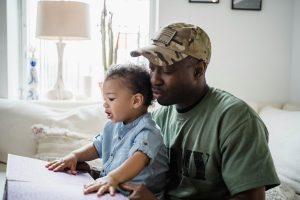The nature of a traumatic event is not completely generalizable and varies from person to person. What constitutes trauma for one person does not necessarily translate to trauma for another. Several factors can determine how a person experiences crisis or otherwise stressful life events. Pain tolerance is not merely an attribute of physical hurt. Emotional and mental pain hold their own tolerance levels. These can be related to psychological resilience, family support, culture, cognition, coping mechanisms, the age at which the event occurred, and other interpersonal, spiritual, and otherwise perceived strengths, supports, and responsibilities.
Although healing is not linear, there does come a time when grief and trauma move from a typical timeline and can cross into complicated grief and post-traumatic stress disorder (PTSD). Both of these disorders occur when grief and trauma surpass a typical emotional, mental, and physical reaction. With both complicated grief and PTSD, the painful emotions and symptomatology that accompany loss do not improve with time and even intensify.
When a person experiences a traumatic event, the parts of the brain that control memory, emotional regulation, and impulses are significantly affected. There is an emotional aspect of PTSD and complicated grief that involves the brain’s ability to process information. When trauma occurs, chemical neurotransmitters cause the traumatic memory to loop in the emotional side of the brain, disconnecting it from the part that controls cognitive processing and reasoning. This can explain why nightmares, emotional outbursts, sensory triggers, flashbacks, and other painful reminders of the event can stay with a person mentally.
This experience can be daunting, intrusive, and triggering. It can interfere with daily life and amplify or contribute to the onset of anxiety, depression, substance use and abuse, and suicidality. The traumatic event is quite literally stuck in the brain, causing perpetual distress and uneasiness. Luckily for many, there are ways to stop the loop. The solution is found in processing, feeling, and ultimately healing.
After three years of countless tears, flashbacks, intrusive thoughts, worsening depression and anxiety, I realized that what was happening to me extended far beyond the typical reaction and length of adjusting to a breakup. After years of still not being “over it” despite desperately wanting to be, it occurred not only to me but to those around me that I needed help. There are reasons why a breakup almost destroyed me. There were reasons why a breakup was traumatic to me. Factors including attachment issues, fears of abandonment, and a heightened sense of sensitivity to rejection contributed to the complicated grief and trauma associated with the romantic loss of a partner.
The breakup felt like a loss that I lacked the language to explain at the ripe age of 17. However, this is where I found that grief and mourning extend beyond a loved one’s death. The stages of grief can easily and commonly do cross into loss of all kinds, including but not limited to loss of a relationship, loss of self, loss of employment, and any other significant changes to one’s reality.
What I needed most was to stop focusing on the timeline that I and others expected of me and to understand the other variables that made this break up so difficult. I needed to process more than just the change in my relationship status, but also the deeper and more complicated aspects of the way I related to and connected and ultimately attached myself to those closest to me. In this processing, elements of the daunting loop were interrupted, understood, and reworked. Coping mechanisms were introduced, and cognitive behavioral therapy (CBT) helped me adopt new ways of thinking and understanding my thoughts, feelings, and reality.
Within the chaos of my looping trauma, I found that one of the main things I lacked was the ability to self-soothe. I could not regulate my emotions. I had always relied on someone else to help me. Now, single, away at college, exhausting all of my emotional supports throughout the years, on the lonely nights where the flashbacks persisted and the pain deepened, I found that the repetitive nature of my worrisome and dark thoughts could be mimicked and curbed. I would open my phone and write to myself, over and over again, “It’s okay. It’s okay. It’s okay. I’m okay. I’m okay. I’m okay.”
With time, I found that the repetitive nature of the messages I wrote to myself and, ultimately, my internal monologue were cathartic. Not only did I begin to find release and relief, but there was also a poetic nature, rhythm, and rhyme scheme to the pain and pattern in my words. My silent coping and self-soothing mechanism inspired me to see the beauty in pain and reimagine the daunting loop of trauma as an opportunity to intercept its narrative and create a new one—that to stop the loop, I had to acknowledge it, feel it thoroughly, and refrain from getting absorbed by it.
If my pain demanded to be seen, heard, and felt, then the only way to possibly rid it was to see, hear, and feel it. And so I did. It was not always pretty, and it was often painful, but with time, therapy, and learning to speak my truth, I was able to visit the depths of my pain and return prepared to un.pack what I discovered through writing. Although my longing to heal exceeded my desire to write, I found solace in both. Becoming an author saved me from myself.
I became a poet because my heart was broken. For me, writing was the most integral part of my processing and healing journey, but there are many other ways that the loop can be interrupted and processing can take place. Exercise, art, therapy, support groups, hobbies, and other social-emotional stimulating activities can be helpful to rewiring your brain.
I am a firm believer that shame and secrecy fuel our inability to seek help and ultimately heal from the internal battles that we face. We want to appear okay. We don’t want anyone to know it still hurts. We don’t want it to still hurt. But on my un.packing journey, I have found that numbing only freezes the pain in space and time. That if you numb pain, you also numb joy. That feeling is the antidote to pain. That there is healing in pain, too. That you, and I and everyone we meet, are worthy of the time it takes to mend the parts of us that need un.packing.
 Want to read un.packing: a collection of poems and prose? Check out the link above!
Want to read un.packing: a collection of poems and prose? Check out the link above!
Your purchases will help support the costs of running rtor.org, a free service of Laurel House, Inc., a 501 (c)(3), nonprofit organization.
About the Author: Aijah Monet is a social worker, poet, and author of un.packing: a collection of poems and prose. To learn more about the un.packing process, join countless others on the journey to self-love, discovery, healing, and community, visit aijahmonet.com and @un.packing on Instagram.
July is BIPOC Mental Health Month
In 2008 the United States government designated July as Bebe Moore Campbell National Minority Mental Health Awareness Month “to enhance public awareness of mental illness …. among minorities.”
Bebe Moore Campbell was an American author and mental health advocate who wrote works of fiction, nonfiction, and children’s literature about the harmful effects of racism and the mental health impacts on those affected.
Each July, www.rtor.org and its sponsor Laurel House, Inc. honor the legacy of Bebe Moore Campbell. We believe in using language that puts people first and emphasizes their individuality and unique contributions rather than their health or demographic status. Just as we do not refer to people living with schizophrenia as “schizophrenics,” we avoid terms such as “minority” and “marginalized” when referring to BIPOC (Black, Indigenous, and People of Color) and BIPOC Mental Health Month.
Please join us in recognizing the unique struggles BIPOC face and bringing awareness to the need for adequate, accessible, culturally relevant mental health treatment, care, and services.
Our recent blog post, 8 Accessible Mental Health Resources for Black, Indigenous, and People of Color (BIPOC), contains several links to online resources promoting the emotional wellbeing and access to mental health care for these communities.
www.rtor.org and Laurel House are committed to the advancement of racial equity and social justice and to making mental health services available to all.
Photo by Eye for Ebony on Unsplash
The opinions and views expressed in any guest blog post do not necessarily reflect those of www.rtor.org or its sponsor, Laurel House, Inc. The author and www.rtor.org have no affiliations with any products or services mentioned in the article or linked to therein. Guest Authors may have affiliations to products mentioned or linked to in their author bios.
Recommended for You
- Veterans and Addiction Recovery: How Families Can Support Their Service Member’s Healing Journey - July 14, 2025
- Trauma-Aware Yoga: A Gentle Path to Healing and Recovery - July 10, 2025
- Why Eating Disorders in Men Are Often Missed - July 3, 2025


 Want to read un.packing: a collection of poems and prose? Check out the link above!
Want to read un.packing: a collection of poems and prose? Check out the link above!


